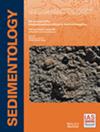On depositional processes governing along-strike facies variations of fine-grained deposits: Unlocking the Little Ice Age subaqueous clinothems on the Adriatic shelf
IF 2.8
2区 地球科学
Q1 GEOLOGY
引用次数: 0
Abstract
Depositional processes recorded by shelf deposits may vary widely along-strike, depending largely on the mode of delivery and deposition of sediments to the basin. In fine-grained systems in particular, depositional processes are difficult to reconstruct with standard facies analysis of sediment cores due to the ostensibly featureless and homogenous appearance of muds. In this study, sedimentological, palaeontological, geochemical and oceanographic data were combined in a detailed characterization of depositional conditions via sedimentary structures, type of organic matter, trace-metal geochemistry and benthic fauna assemblages (foraminifera and ostracods) along the 600 km long shelf delta clinothems of the West Adriatic shelf (Italy). Processes inferred from sedimentary facies and micro-structures were then considered in the context of the modern Adriatic oceanographic regime. Specific attention was given to the Little Ice Age stratigraphic unit (1500–1850 CE), which contains a continuum of genetically related fine-grained strata. The Little Ice Age deposit offers the opportunity to examine a source-to-sink system with the high resolution typical of modernanalogues, at a time interval when Apennine rivers were not yet hydraulically engineered with man-made sediment traps along their trunks. Individual beds within the Little Ice Age muddy prodelta form hectometre to kilometre-wide bedsets that reflect the interplay between energetic meteo-ocean conditions (storm-dominated beds), flood supply (river-dominated beds or hyperpycnites) and along-shelf bottom-current dispersion (drift-dominated beds). The multidisciplinary approach applied at different scales of observations helped in understanding sediment provenance and the relative timing of sediment transport before final burial that strongly promoted organic matter oxygen exposure and the loss of carbon by microbial degradation. Overall, the distinctive depositional processes that acted in concert along the prodelta slope produced a subtle lateral heterogeneity of preserved sedimentary structures, faunal associations and organic matter composition in a laterally-continuous lithostratigraphic unit deposited at centennial scale. These findings have implications on the forcing conditions that ultimately control the location and nature of fine-grained beds in both modern and ancient, mud-dominated depositional systems.控制细粒沉积物沿走向相变化的沉积过程:亚得里亚海陆架小冰期水下覆岩的解开
陆架沉积物记录的沉积过程可能沿走向变化很大,这主要取决于沉积物向盆地的输送和沉积方式。特别是在细粒体系中,由于泥浆表面上无特征且均质,沉积过程很难用沉积物岩心的标准相分析来重建。本研究结合沉积学、古生物学、地球化学和海洋学数据,通过沉积构造、有机质类型、微量金属地球化学和底栖动物组合(有孔虫和介形虫),详细描述了西亚得里亚海陆架(意大利)600公里长的陆架三角洲边缘地带的沉积条件。然后在现代亚得里亚海海洋学制度的背景下考虑从沉积相和微观结构推断出的过程。特别注意到小冰期地层单元(1500-1850 CE),它包含一个连续的遗传相关的细粒地层。小冰期沉积物提供了一个机会,以现代类似物的典型高分辨率来研究一个从源头到汇的系统,当时亚平宁河还没有通过水力工程在其干流沿线设置人工沉积物陷阱。小冰河期泥质前三角洲内的单个河床形成了几公里至几公里宽的河床,反映了高能气象-海洋条件(风暴主导的河床)、洪水供应(河流主导的河床或高斑岩)和沿陆架底流分散(漂流主导的河床)之间的相互作用。在不同观测尺度上应用的多学科方法有助于了解沉积物的来源和沉积物在最终掩埋之前的相对时间,这强烈促进了有机质的氧暴露和微生物降解导致的碳损失。总的来说,沿前三角洲斜坡共同作用的独特沉积过程在百年尺度的横向连续岩石地层单元中产生了保存的沉积构造、动物组合和有机质组成的微妙的横向非均质性。这些发现对最终控制现代和古代泥质沉积体系中细粒层的位置和性质的强迫条件具有启示意义。
本文章由计算机程序翻译,如有差异,请以英文原文为准。
求助全文
约1分钟内获得全文
求助全文
来源期刊

Sedimentology
地学-地质学
CiteScore
8.20
自引率
11.40%
发文量
94
审稿时长
6-12 weeks
期刊介绍:
The international leader in its field, Sedimentology publishes ground-breaking research from across the spectrum of sedimentology, sedimentary geology and sedimentary geochemistry.
Areas covered include: experimental and theoretical grain transport; sediment fluxes; modern and ancient sedimentary environments; sequence stratigraphy sediment-organism interaction; palaeosoils; diagenesis; stable isotope geochemistry; environmental sedimentology
 求助内容:
求助内容: 应助结果提醒方式:
应助结果提醒方式:


